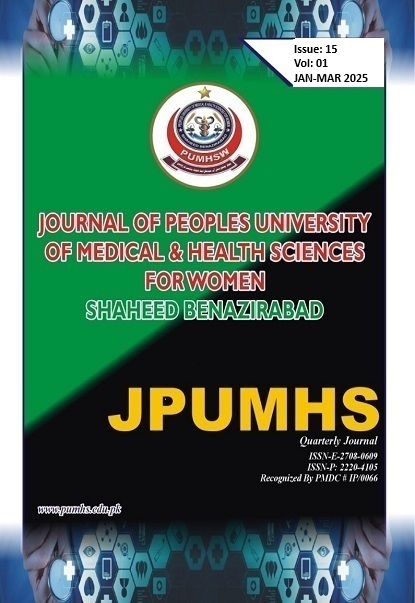FREQUENCY AND ANTIBIOGRAM OF PSEUDOMONAS AERUGINOSA IN A TERIARY CARE HOSPITAL.
JPUMHS; 2025:15:01,180-187. http://doi.org/10.46536/jpumhs/2025/15.01.611
Keywords:
Pseudomonas aeruginosa, Antimicrobial resistance, Gender differences, Antibiotic susceptibility, Healthcare-associated infections, Pakistan, Public healthAbstract
BACKGROUND: Pseudomonas aeruginosa is a significant cause of healthcare-associated
infections, with rising antimicrobial resistance posing a global public health challenge.
OBJECTIVE: This study aimed to evaluate the frequency, antibiogram, and gender-based
distribution of P. aeruginosa isolates in a tertiary care hospital in Pakistan. METHODS: This
cross-sectional study was conducted from January to December 2023. Clinical samples were
collected from 502 patients and processed using standard microbiological techniques.
Antibiotic susceptibility testing was performed using the Kirby-Bauer disk diffusion method,
and data were analyzed for gender-based differences and resistance patterns. RESULTS: The
majority of patients were male (60.6%, n=304), while females accounted for 39.4% (n=198).
Blood samples were the most common (53.4%, n=268), followed by tissue and fluid samples
(14.3%, n=72 each). The medical ward contributed the highest number of samples (59.6%,
n=299, p=0.004). Meropenem exhibited the highest sensitivity (90.4%, n=454), while
Levofloxacin showed moderate sensitivity (65.9%, n=331, p<0.001). Gender-based differences
were observed, with males showing higher sensitivity to Levofloxacin (224 vs. 112) and Co-
trimoxazole (285 vs. 162, p<0.001). Resistance rates for Capreomycin (48.8%, n=245) and
Minocycline (25.1%, n=126) were higher in females. Significant differences in sample
distribution and susceptibility patterns were noted across genders and wards.
CONCLUSIONS: This study highlights the high burden of P. aeruginosa infections and
antimicrobial resistance in Pakistan, emphasizing the need for antimicrobial stewardship
programs and gender-sensitive approaches to infection control. Targeted interventions in high-
burden wards are essential to mitigate the impact of resistant infections.
Downloads
Downloads
Published
How to Cite
Issue
Section
License

This work is licensed under a Creative Commons Attribution-NoDerivatives 4.0 International License.




